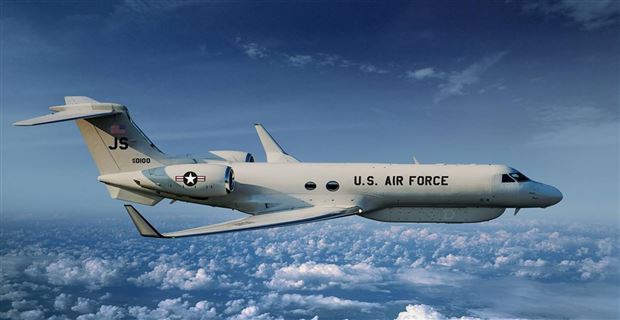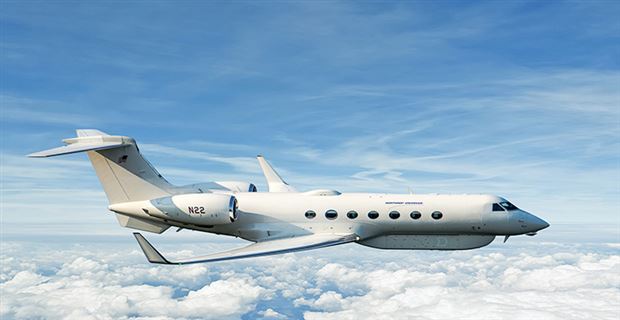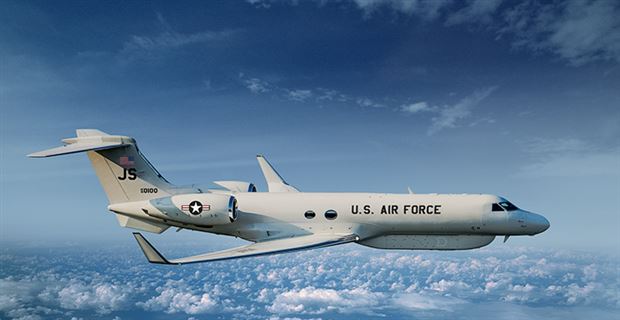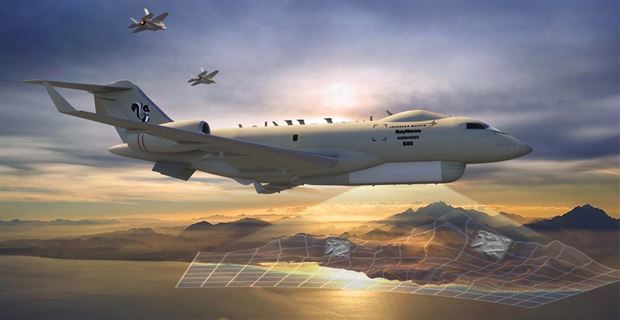The U.S. Air Force operates a small fleet of radar planes that can track moving ground targets in the fog of war, warning friendly forces of approaching danger while vectoring strike aircraft to counter the threat. Called the Joint Surveillance Target Attack Radar System (J-Stars), the 17 modified Boeing jetliners in this fleet are in continuous demand from regional military commanders. And with good reason: no other Air Force asset can track 600 moving ground targets simultaneously at distances in excess of 150 miles.
Because the planes have battle managers on board, they can compress the "kill chain" of steps that must be accomplished to eliminate surface threats to U.S. soldiers. Time is critical when the threat is moving. Using J-Stars, tactical commanders can know with high accuracy where enemy vehicles and troops are, what direction they are moving in, and at what speed. They can also receive images of the enemy force generated by the plane's radar -- images obtainable even in the dead of night, or when it is foggy, or when a dust storm is raging. In addition, they can learn where friendly ground forces are on the battlefield.
This is invaluable information for protecting U.S. warfighters, securing tactical objectives, and avoiding deaths from friendly fire. But J-Stars is old. Its radars were installed decades ago on previously-owned commercial jetliners that today exhibit metal fatigue, corrosion and technical obsolescence. The Air Force had been planning a "recapitalization" (replacement) program for the fleet known in the inevitable piece of Pentagon jargon as J-Stars Recap. It said fielding successor planes by 2021 was a matter of high urgency.
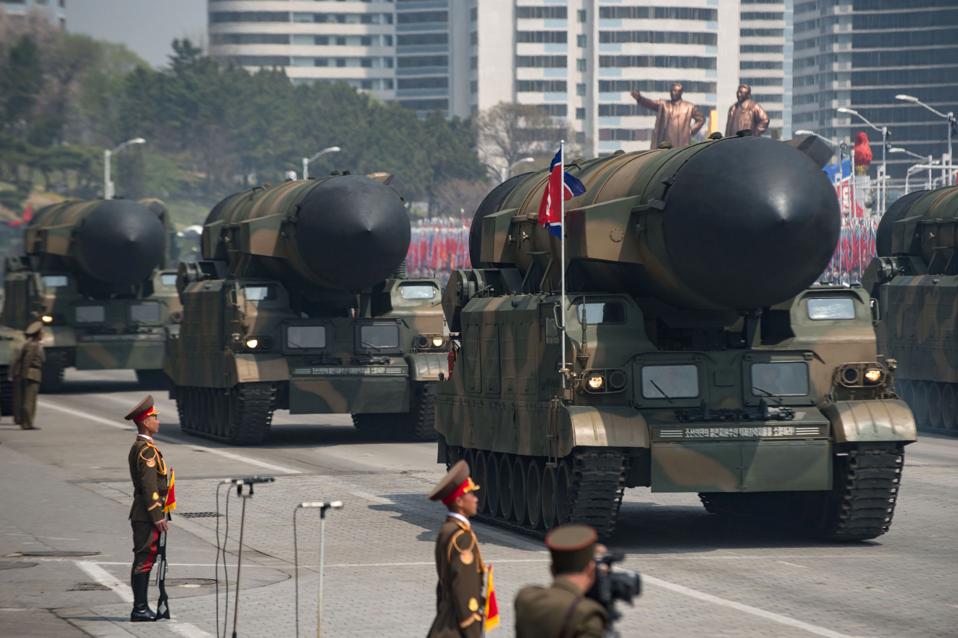
North Korea plans to operate its future intercontinental ballistic-missile force on mobile launchers. Without a system like J-Stars to track the movement of such launchers, it would be impossible to destroy the missiles before they were launched. (Ed Jones/AFP/Getty Images)
And then last summer, the Air Force suddenly changed course. It said the aging planes could remain airworthy until 2030, and that new radar planes would be too vulnerable in the contested air space of future war zones. It argued a better arrangement would be to network other sensors -- most of them already in the force -- to fashion a more survivable approach to tracking moving ground targets. That's the course on which the service has now embarked. But Air Force leaders have left some key details out of their explanation for the sudden change of plans.
Several companies with a potential stake in the modernization of the J-Stars fleet contribute to my think tank. Some are consulting clients.
https://www.forbes.com/sites/lorent...ecap-of-the-j-stars-radar-plane/#1a0c2daf36ea
@khafee @I.R.A
Because the planes have battle managers on board, they can compress the "kill chain" of steps that must be accomplished to eliminate surface threats to U.S. soldiers. Time is critical when the threat is moving. Using J-Stars, tactical commanders can know with high accuracy where enemy vehicles and troops are, what direction they are moving in, and at what speed. They can also receive images of the enemy force generated by the plane's radar -- images obtainable even in the dead of night, or when it is foggy, or when a dust storm is raging. In addition, they can learn where friendly ground forces are on the battlefield.
This is invaluable information for protecting U.S. warfighters, securing tactical objectives, and avoiding deaths from friendly fire. But J-Stars is old. Its radars were installed decades ago on previously-owned commercial jetliners that today exhibit metal fatigue, corrosion and technical obsolescence. The Air Force had been planning a "recapitalization" (replacement) program for the fleet known in the inevitable piece of Pentagon jargon as J-Stars Recap. It said fielding successor planes by 2021 was a matter of high urgency.

North Korea plans to operate its future intercontinental ballistic-missile force on mobile launchers. Without a system like J-Stars to track the movement of such launchers, it would be impossible to destroy the missiles before they were launched. (Ed Jones/AFP/Getty Images)
And then last summer, the Air Force suddenly changed course. It said the aging planes could remain airworthy until 2030, and that new radar planes would be too vulnerable in the contested air space of future war zones. It argued a better arrangement would be to network other sensors -- most of them already in the force -- to fashion a more survivable approach to tracking moving ground targets. That's the course on which the service has now embarked. But Air Force leaders have left some key details out of their explanation for the sudden change of plans.
- Five studies said a new radar plane was needed before a sixth said it wasn't. The question of what to do about the aging J-Stars fleet has been studied to death. Five different studies came to the conclusion that a new airframe hosting an improved radar and on-board battle managers was needed to continue accomplishing a vital mission. And then, out of the blue, a sixth assessment came to the opposite conclusion shortly after a new leader was installed at the service's air combat command. This reversal appears to be more about personalities than mission requirements.
- All of the previous studies covered the same ground as the sixth. The Air Force didn't suddenly discover last summer that flying near Russia or China in a future war might be a little more dangerous than overflying ISIS. Nor did the value of having human battle managers on board as a way of compressing the kill chain suddenly get called into question. The Air Force just changed its mind about what the data meant, without any public explanation of why. Unfortunately, it could change its mind again, and again, while the J-Stars fleet gradually decays.
- If J-Stars isn't survivable, neither are tankers, transports and other parts of the force. Isn't it a bit odd that the survivability of militarized commercial jets would become a decisive issue in recapitalizing J-Stars at the same time the Air Force is executing a multi-decade program to replace its equally old tankers with modified jetliners? With the exception of fifth-generation fighters, all of the airframes in the joint fleet are subject to survivability concerns. That's why the top priority for the stealthy F-22 and F-35 during the early days of future wars will be to suppress enemy air defenses.
- The Air Force doesn't have an alternative to the current system. The Air Force's proposed alternative to J-Stars has barely reached the advanced PowerPoint stage. It lacks the sensor systems, communications links, processing centers and battle management network to replicate what today's radar planes deliver. Kluging together all the necessary pieces would cost many billions of dollars, and would take more time to accomplish than the service has before current radar planes must retire. Just look at all the time and money the service has spent trying to secure its existing networks from cyber attack.
- Drones will not survive in future combat, and satellites might not either. Since the Air Force is arguing against a new generation of manned radar planes, its notional alternative presumably would utilize unmanned aircraft ("drones") and satellites instead. But drones lack protection from enemy air defenses, and the command links to their remote pilots have been known to fail even when they are not being jammed. The Air Force Space Command is warning that satellites used for sensor collection and communications relay will be subject to disruption by enemies in the future. If survivability is the issue, drones and spacecraft aren't the answer.
- You need 6-8 drones to take the place of one J-Stars plane. The only unmanned aircraft the Air Force currently operates that is equipped with a radar for tracking moving ground targets is the Block 40 variant of the Global Hawk. It's an impressive piece of technology, but because its radar aperture is much smaller than that on a J-Stars plane, several would be needed to match the sensing capability of a single J-Stars. Unfortunately, the Air Force only bought 11 of the Block 40 variants, and it has no plans to buy more. On a good day, its entire complement of Block 40s might be able to match the tactical performance of two J-Stars planes.
- The Air Force tried to kill the drone best suited to take the place of J-Stars. Few observers today seem to recall that only a few years back, the Air Force was considering cancellation of the Block 40 variant of Global Hawk. In 2013, the Block 40 was offered up in budget deliberations as a bill-payer for "higher priorities." Now it bulks large in the service's plan for killing a successor to J-Stars. The obvious implication is that Air Force leaders have no strong convictions about how the tracking of moving ground targets should be accomplished. A more troubling possibility is that they don't care about the mission at all.
- J-Stars planes can be kept airworthy a few more years, but that's not the same as available. Although the Air Force's projection of when existing radar planes must be retired has been pushed back to 2030, that doesn't change the fact that on any given day, a third of the planes are tied up in maintenance. Boeing stopped building the 707 airframe 40 years ago and the Air Force elected not to replace the plane's antiquated engines when it had the chance, so planes are frequently unavailable due to required maintenance. It has been estimated that the cost of recapitalization ($6-9 billion) is less than the cost of keeping the legacy fleet flying (around $11 billion).
- U.S. combatant commanders count on having ground moving-target trackers available. The J-Stars fleet has been in continuous demand from U.S. combatant commanders since Operation Desert Storm a quarter century ago. For instance, it is on patrol over the Korean Peninsula today, monitoring the movement of North Korean artillery, armored vehicles and missile launchers. So the idea that the Air Force would suddenly stop the long-planned recapitalization of this unique but aging fleet in order to pursue a nebulous alternative on no certain timeline is dangerous -- particularly for the lives of America's soldiers on the ground in foreign war zones.
- The Air Force has a long history of suddenly discovering convenient information. This isn't the first time the Air Force suddenly discovered it could change a plan previously regarded as critical and time-sensitive. It tried to kill the unique U-2 spy plane several years back despite lacking a viable alternative for some of the plane's most vital missions, and it tried something similar with the A-10 Thunderbolt II close air support plane. In both cases, Congress stepped in because it doubted the adequacy of the Air Force's data and analysis. The sudden reversal on J-Stars recapitalization after years of agreement on what needs to be done looks like a repetition of the same pattern.
Several companies with a potential stake in the modernization of the J-Stars fleet contribute to my think tank. Some are consulting clients.
https://www.forbes.com/sites/lorent...ecap-of-the-j-stars-radar-plane/#1a0c2daf36ea
@khafee @I.R.A

